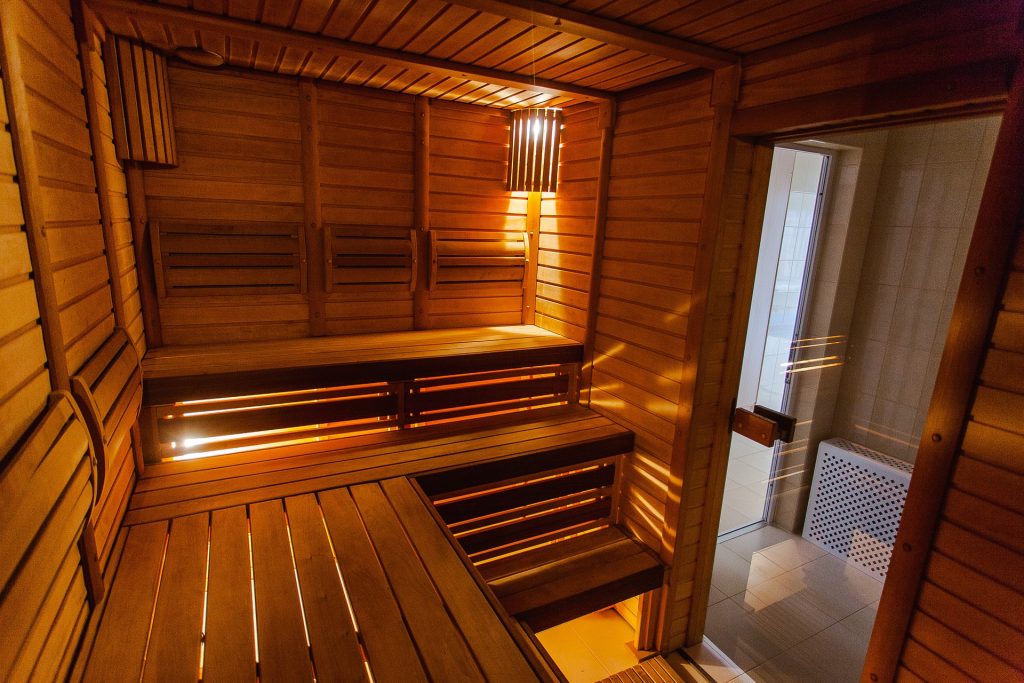Dry Sauna Therapy

The oldest known use of sauna for health practices traces back thousands of years to Finland. Modern Scandanavian saunas typically use a metal heater in a wooden room with temperatures upwards of 165-212°F. More recent innovations for sauna therapy include infrared or far infrared sauna with unique heating elements that can heat the body more effectively at lower temperatures.
Dry sauna was established as a health promoting practice, and recent research appears to support that assumption. Sauna has long been seen as a cleansing process or ritual for cleaning out the body through sweating. Yet, it’s surprising how controversial it has become. A simple google search found multiple websites, blogs and news stories stating emphatically that you can’t sweat out toxins. Most failed to link to any research supporting their claim.
Sauna as a Detoxication Therapy
The skin is the largest organ of detoxication and studies show that sweat contains heavy metals, pesticides, plastic compounds and other toxicants. In individuals with a high exposure history to heavy metals, more metal can be removed by sweat than by urine (Sears 2012). Phthalates are toxins from plastic that disrupt hormones throughout the body. Sweating has also been shown to help clear phthalates. Concentrations in some cases were twice as high in sweat as compared to urine, again indicating more effective clearance through sweat (Genuis 2012).
Pesticides are often neurotoxic, and concerns linger over exposure. Organochlorinated pesticides are of significant concern and many have been banned, including DDT. Sweat samples in people more often contain detectable organochlorinated pesticides than urine or blood, again showing these compounds are more effectively eliminated directly through sweating (Genuis 2016). The same research group found similar results for flame retardant chemicals and bisphenol A (Genuis 2017, Genuis 2012).
While sweating as a way to remove toxicants has support in the research, health improvements from sweating out toxicants through sauna use hasn’t been well investigated. One study on Gulf War illness, a poorly understood condition that appears to have links to toxic exposures, showed that sauna combined with nutrients improved pain, energy and quality of life. The benefits seemed durable, mostly remaining intact after three months (Kerr 2019)
While researched health benefits from removing toxins through sauna therapy are not robust, research on other conditions is more prevalent. Sauna appears to help cardiovascular disease, brain health and pain conditions.
Sauna and the Heart
A 2018 review on the heart benefits of sauna in the journal Mayo Clinic Proceedings found that acute exposure to sauna lowered blood pressure and improved arterial stiffness. And while more research is needed, studies suggest that regular sauna use reduces the risk of developing hypertension by 47% (Laukkanen 2018).
Sudden cardiac death also appears reduced with sauna use. Comparing men who only had one sauna session per week, men that used it 2-3 times per week reduced sudden cardiac death by an additional 22%. Those that used it for 4-7 sessions per week reduced risk 63%. Of interest, they found similar results for fatal cardiovascular disease and even all cause mortality. Higher sauna use seemed helpful for reducing death from any cause (Laukkenan 2015).
Sauna and Brain Health
Intuitively, you might think that heat exposure from sauna use long-term might have negative consequences on the brain. However, the opposite has been found. In a study looking at men between the ages 42 and 60, again they compared one sauna session per week to more. Men that used the sauna 2-3 times per week reduced risk of dementia by 21%. Those that used it 4-7 times per week reduced risk by 65%.
Heart disease and dementia can both be devastating illnesses. Such sharp reductions in these conditions with sauna therapy demonstrates some potentially profound benefits.
Sauna and Pain

Far-infrared (FIR) sauna has been studied in chronic pain and fibromyalgia. In a multidisciplinary treatment that either included or excluded FIR sauna treatments, patients that had sauna therapy had better outcomes than those without. While the study was small, at the two year mark, 77% of patients that had therapy that included sauna treatment returned to work as compared to 50% without sauna therapy (Masuda 2005).
Fibromyalgia is widespread body pain without a known physiological cause. Standard treatments usually only provide modest improvements at best. Far-infrared sauna reduced fibromyalgia pain by around half after the first session. With 10 sessions of therapy, benefits stabilized even after an average of 14 months (Matsushita 2008).
An older study on Finnish dry sauna, described a gender difference in treating pain conditions. Men seemed to mostly find benefits, whereas about 25% of women did not. They also noted that proper cooling after the sauna session was important since without it, pain could increase transiently after the session (Isomaki 1988).
Types of Dry Sauna: Finnish versus FIR
Historically, Finnish dry saunas were the most commonly available. More recently, far-infrared saunas have increased in popularity. Far-Infrared heat penetrates more deeply into body tissues heating the body more effectively. Thus, it’s easier to reach similar levels of sweating and internal temperatures with much lower temperatures in a FIR sauna. FIR sauna temperatures usually range between 120-145°F. Both types of sauna appear to give health benefits, but we need more research to know for sure if they are equivalent.
Sauna Safety
Sauna is generally safe when used properly, although there are some standard safety recommendations. It’s not recommended for pregnant women to use a sauna due to concerns for harm to a developing fetus. When first using a sauna, start slow and build up your tolerance. If your heart rate exceeds 140 beats per minute, it’s a likely indication that it’s too hot or you’ve been in the sauna for too long (Postawski 2019). Drink plenty of water. A simple approach is to weigh yourself before and after a sauna session. If you’ve lost weight, you didn’t drink enough water. Do not use sauna sessions for quick weight loss.
After sauna, it’s also important to cool down. Taking a cool shower or swimming in a pool can help restore body temperature more quickly.
For most healthy people, saunas are a simple and safe health-promoting activity. If you have a chronic illness, it’s worth talking with your doctor to make sure saunas can be safely used in your situation.
Conclusion
Saunas have a long history of use for promoting health and wellbeing. The latest research suggests significant benefits from sauna for heart disease, brain health and chronic pain. Data also appears to indicate that sweating promotes the increased clearance of toxicants from the body. If you enjoy the relaxation benefits of sauna bathing, it’s likely worth using a sauna on a regular basis to support your own wellbeing.




I’m looking to make a DIY sauna. Would you recommend going with all Far-infrared elements. or a mix of near and far infrared. I’m curious about the different benefits of the two types. Thanks 😉
The more robust findings on sauna, at this point, are related to Scandinavian dry saunas. However, my own personal experience seemed to indicate that far-infrared sauna encouraged more detox effects, although that finding needs more research to be validated. Far-infrared saunas have the additional advantage of a lower working temperature, so they can be more comfortable for the user. Far-infrared rays are absorbed better by the body and a lower temperature can still effectively promote sweating. I have used both types of sauna, but currently prefer far-infrared.